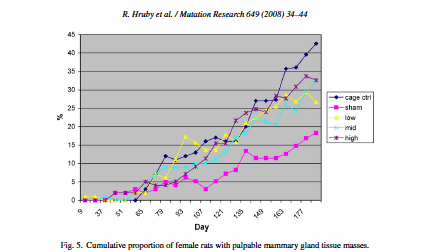Stress Can Protect Against Cancer; New Study Confirms Confounding in Cell Phone Animal Project
Mice that were placed under short-term stress before being exposed to UV radiation, a known cancer-causing agent, developed fewer skin tumors than those that just got the UV. These new findings from Firdaus Dhabhar's lab at Stanford University medical school were released by Brain, Behavior and Immunity a few days ago.
Dhabhar's study is the first specifically designed to test the hypothesis that stress can protect against tumors. But his results are eerily similar to those obtained in a set of $10 million animal experiments, known as PERFORM-A, that were supposed to investigate the cancer risks associated with cell-phone radiation. In each case, the animals were restrained inside plastic tubes: in Dhabhar's study to put the mice under stress, and in the PERFORM-A project to keep the animals in a fixed position in order to deliver a well-defined dose of radiation. And, in each case, the stress had a dramatic —and very similar— impact on the animals.
In the six PERFORM-A experiments, carried out in six different countries, mice and rats that were restrained for a few hours a day developed, in most cases, fewer tumors than free-roaming animals. See, for instance, the graph below from the PERFORM-A study on rats by Robert Hruby at what is now known as the Austrian Institute of Technology.

Compare the incidence of tumors among the shams (in pink), which were restrained inside the tubes and placed in a Ferris wheel exposure system but did not get any radiation, with that of the cage controls (top, in blue), which also did not get any radiation, but were allowed to run free. (The three middle curves are for the rats that were exposed to varying levels of RF/microwave radiation in the Ferris wheel.) The shams had much fewer tumors —a result that is consistent with Dhabhar's study.
Dhabhar applied the stress intentionally to see its effect on tumor formation; the PERFORM-A researchers did it in error, a side effect of the experimental design. The two sets of results may help us get a better handle on the biology of stress. But it also means that the PERFORM-A results cannot do what they were supposed to do. They cannot shed light on whether cell phones can lead to cancer because the effects of the stress are mixed up with any possible effects of the radiation, and they cannot be disentangled.
There are many differences between the two studies. For instance, in the Dhabhar experiment, the mice were placed inside the plastic tubes for two-and-a-half hours before their 10-minute UV exposures. In the Hruby study, the rats were restrained in the tubes for four hours a day during the radiation or sham exposure. Also Dhabhar only put the mice under stress for the first ten weeks of his 32-week study. Hruby's sham-exposed rats were placed in the tubes throughout the six-month experiment. And most of all Dhabhar's animals were treated with radiation, while the shams in PERFORM-A were not. Nevertheless, the similarity of the results is remarkable.
Members of the PERFORM-A project chose to ignore the possible confounding effects of stress on the animals, even after a preliminary experiment clearly indicated that mice placed in the exposure system were showing biochemical signs of stress. For a detailed discussion of these RF-animal experiments, see our special report: "Wheel on Trial: $10 Million Industry Research Project Flops." Nor has there been any detailed discussion of the potential role of stress in the PERFORM-A studies since the final results were published. All the while, they continue to be cited as evidence that mobile phones are cancer-free. PERFORM-A was the brainchild of Motorola and was largely funded by the mobile phone industry through the MMF and the GSMA, with support from the EC's Fifth Framework Program.
For more on Dhabhar's study, see his abstract, the Stanford press release and the write-up in The Scientist. For specifics on each of the PERFORM-A experiments, including tumor counts, see the Table of Cell Phone Animal Studies (1997–2007), which is part of our special report, "Wheel on Trial."
